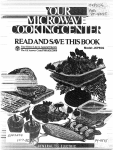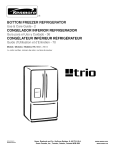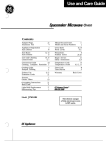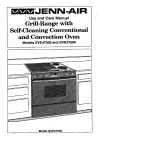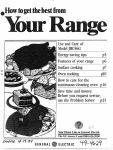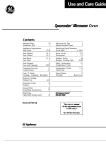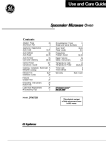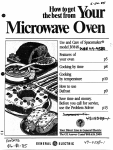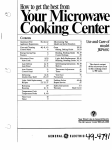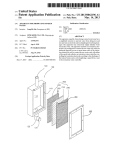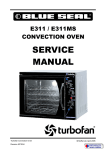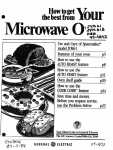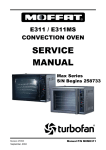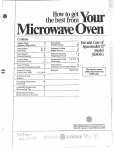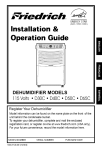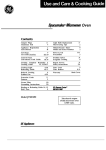Download GE JEM31H User's Manual
Transcript
Spacemakerll’”Micwie Oven Contents Adapter Plugs Appliance Registration 19 2 Auto Defrost Auto Roast 12, 13 10,11 Microwaving Tips Minute/Second Timer 2 Model and Serial Numbers Precautions 2 3 Auto Simmer Care & Cleaning 17 Probe Problem Solver Control Panel Conversion Guide 6 12 Program Cooking Repair Service 11 7 5,6,9-11,17 18 6 27 Cook ‘NWatch Cooking by Temperature 8 9 Safety Instructions 3,4 To Removefkom Cabinet Mount 25 Cooking by Time Cooking Complete Reminder 8 5 Under Cabinet Mounting 20-25 Warranty Back Cover Delayed Cooking Double Duty Shelf 7 4,5, 15-17 Extension Cords Features 19 5 Grounding Instructions Hold Time 19 7 Light Bulb Replacement Manual Defrost 17 ModelJEM31H GEAppRmces 14 GEAmww Centw@ 8M.62E24W The electric output of this microwave oven is 700 watts. Help us help you... Before using your oven, read this book carefully. It is intended to help you operate and maintain your new microwave oven properly. Keep it handy for answers to your questions. If you don’t understand something or need more help, write (include your phone number): Consumer Affairs GE Appliances Appliance Park Louisville, KY40225 Write down the model and serial numbers. You’llfind them on a label inside the oven. These numbers are also on the Consumer Product Ownership Registration Card that came with your microwave oven. Before sending in this card, please write these numbers here: Model Number Please check with your supplier to be sure he has done so; also send in your Consumer Product Ownership Registration Card. If you move, or if you are not the original purchaser please write to us, stating model and serial numbers. This appliance mustbe registered.Pleasebe certain that it is. Write to: GE Appliances Range Product Service Appliance Park Louisville, KY40225 If you received a damaged oven... Immediately contact the dealer (or builder) that sold you the oven. Save time and money. Before you request service .. . check the Problem Solver on page 18. It lists causes of minor operating problems that you can correctyourself. When unpacking your microwaveoven... Use these numbers in any correspondence or service calls concerning your microwave oven. you should find an installation package that contains a template and installation hardware for under-the-cabinet mounting. If missing, contact your supplier. Be sure your microwave oven is registered. Optional Accessories Serial Number It is important that we know the location of your microwave oven should a ned occur for adjustments. Your supplier is responsible for registering you as the owner. available at extra cost from your GE supplier. JX8H Installation Kit converts this oven to a built-in wall oven. 2 Microwaving Tips ● Make sure all cookware used in your microwave oven is suitable for microwaving. Most glass casseroles, cooking dishes, measuring cups, custard cups, pottery or china dinnerware which does not have metallic trim or glaze with a metallic sheen can be used. Some cookware is labeled “suitablefor rnicrowaving~’ If you are unsure, use this dish test: Measure 1 cup water in a glass cup. Place in oven on or beside dish. Microwave 1-1%minutes at High. If waterbecomes hot, dish is microwave safe. If dish heats, it should not be used for microwaving. ● Paper towels, wax paper, and plastic wrap can be used to cover dishes in order to retain moisture and prevent spattering. ● Some microwaved fds require stirring, rotating, or rearranging. Check your cookbook. ● Steam builds up pressure in foods which are tightly covered by a skin or membrane. Pierce potatoes, egg yolks and chicken livers to prevent bursting. Features of YourOven Cooking Complete Reminder (Forall Am ROAST codesexceptcode ~ AUIU DEFROST, COOK ‘NWA~H, TIME COOK and MANUAL DEFROST cycles) Toremind you that you have food in the oven, the oven will beep once a minute until you either open the oven door or touch the CLEAR/OFF pad. Q 9 II 1 II I } w-i t 1. Door Latches. 2. Door Screen. Metal screen permits viewing of foods and keeps microwaves confined inside oven. 3. Oven Vent. 4. Model and Serial Numbers. .9 Cubic Foot Oven Interior I I mm I 5. Oven Interior Light turns on when the door is opened or when the oven is operating. 8. Touch Control Panel and Display. See next page for instructions. 6 MICROTHERMOMETERTM Temperature Probe. Use with AUTO ROAST or TEMP COOK/HOLD fi.mctiononly. 9. Door Latch Release. Press latch release bar at indent to open door. Door must be securely latched for oven to operate. 7. DOUBLE-DUTYTM Shelf. Lets you microwaveseveralfoods at once. (See Safety Instructions and pages 15and 16for special instructions.) When this she~fis not in use, please remove from the oven. “ 10. Auto Roast and Auto Defrost Guides. Contain cooking information for the Automatic Roasting function (see page 10) and defrosting information for the Automatic Defrosting fi.mction(see page 12). When YouPlug in the Oven The display panel lights up. After 15seconds, all lights disappear and “RESET” appears. Touch the CLEAR/OFF pad and oven is ready for use and the clock can be set. If power is disrupted at any time, the above sequence reoccurs, and you must reset Clock after touching CLEAR/OFF. 5 YourTouch Control l%nel 9. TEMP COOK/HOLD. Use the temperature probe to cook by using a preset temperature. Once oven reaches preset temperature, it switches to HOLD setting and maintains that temperature until you touch the CLEAR/OFF pad. (See page 9.) The Touch Control I%nel allows you to set the oven controls electronically with the touch of a finger. It’s designed to be easy to use and understand. 1. TIME COOK I & II. Microwave for a preset amount of time using automatic power level 10 (High), (or change power level after entering cooking time. See page 8.) 10. MIN/SEC TIMER. This feature uses no microwave energy. It functions as a kitchen timer, as a holding period after Manual Defrost or as a delay timer before Time Cook I & II, Temp Cook/Hold or Auto Roast. (See page 7.) 2. MANUAL DEFROST. Gentle thawing at automatic power level 3 (Low). (If desired, you may change power level after entering defrosting time. See page 14.) 11. COOK ‘N WA~H. Use this pad for short-term cooking. The oven automatically turns off after 3 minutes. (See page 8.) 3. POWER LEVEL. Touch this pad before entering another power level number if you want to change from automatic power level 10 (High) for cooking or power level 3 (Low) for defrostfig. - 12. CLOCK. Touch this pad to enter time of day or check time of day while microwaving. To set clock, first touch CLOCK pad and then enter time of day. For example, if time is 1:30, touch number pads 1, 3, and Oand “1:30” will appear in display. Touch STARTpad. To reset or change time, simply repeat above process. 4. NUMBER PADS. Touch these pads to enter cooking/deksting time, power level, time of day, finished food temperature, Auto Roast codes and Auto Defrost weights. 5. MIN. Use with number pads to enter whole minutes. For example, for 4 minutes touch 4 and MIN. 6 START. After all selections are made, touch this pad to start oven. 7. AUTO ROAST. Insert probe, touch this pad, and desired number pad for Code to slow-cook or temperature cook meat with automatic preset program. (See pages 10and 11.) & DISPLAY. Displays time of day, time counting down during cooking functions, power level, internal fbod temperature, Auto Roast codes and Auto Defrost food weights, cooking mode and instructions. “PROBE” Appears On Display: . Probe has been forgotten when AUTOROASTor TEMP COOK/ HOLD function is being used. s Probe is not securely seated in oven wall receptacle. B. CLEAR/OFF. When touched, it shuts off the oven and erases all settings (except time of day). 14. AUK) DEFROST. Touch this pad and then the number pads for the desired food weight. The oven automatically sets power levels and defrosting time. (See pages 12 and 13.) Program Cooking Use your Touch Control Panel to Auto Roast or Auto Defrost with the oven automatically setting the times and power levels for you, Manual Defrost, Time Cook and Cook ‘N Watch with choice of power levels from 1 (lowest) to 10(highest), time kitchen tasks with the Min/Sec Timer, and set the clock. 6 Create your own programs to suit your individual cooking style. For example: use the Min/Sec Timer to delay the start of Auto Roast, Temp Cook/Hold or Time Cook I & II or program a hold time between Manual Defrost and Time Cook I & II. (See page 7.) Set Time Cook I &II for a two-stage program using different times and power levels. (See page 8.) ~ How to Use the Minute/Second Timer The MIN/SEC TIMER has three timing functions: ● It operates as a minute timer. ● It can be set to delay cooking. ● It can be used as a hold setting after defrosting. Step 1: Take casserole from freezer and place in oven. Step %Touch 2,5 and MIN for twenty-fiveminutes of cooking time. “COOK TIME” flashes and 25:00 and “POWER 10”appear on display. The MIN/SEC TIMER operates without microwave energy. How to 13me a 3-Minute Phone Call 1. Touch MIN/SEC TIMER pad. The display shows :0 and “ENTER TIME” flashes. 2. Touch number pad 3 and MIN (for 3 minutes and no seconds). Display shows 3:00 and “TIME” flashes. 3. Touch START.Display shows “TIME” and time counting down. 4. When time is up, oven signals, flashes “EndJ’ and display shows time of day. Programming a HOLD TIME Step2: TouchTIME DEFROST pad. Step 8: TouchST~. “DEF TIME” and 15:00 counting down show on display. As each function is automatically performed oven display shows instructions entered and the function. The display shows :0 and “POWER 3:’ “ENTER DEF TIME” flashes. Step 3: Touch pads 1,5 and MIN for 15minutes defrosting time. 15:00 appears on display. (Defrosting is automatically set on power level 3 but can be changed by touching the POWER LEVEL pad and the desired power level.) The Minute/Second Timer can also be used to program “hold time” between microwave cooking fimctions. The time can range from one second to 99 minutes and 99 seconds. A HOLD, or “standing” time may be found in some of your own recipes or cookbook. Programming Delayed Cooking To delay cooking up to 99 minutes and 99 seconds, touch TIME COOK I & II, TEMP COOK/HOLD or AUTO ROASTand enter cook time, temp, or code. Touch MIN/SEC TIMER and enter number of minutes to delaycooking.TouchST~. Tmer counts down to zero and cooking begins. When delaying temperature or Auto Roast cooking, be sure probe is in food before pressing START. How to Manual Defrost, Hold and Time Cook Let’ssay you wantto defrosta frozen casserole for 15minutes, hold for 10minutes and then Time Cook for 25 minutes. Here’s how to do it: Step 4: Set standing or hold time by touching MIN/SEC TIMER. The display shows :0 and “ENTER TIME” flashes. Step 5: Touch 1,0 and MIN to hold for ten minutes. 10:00 appears on display and “TIME” flashes. Step 6: Touch TIME COOK I & II pad. The display shows :0 and “POWER 10:’ “ENTER COOK TIME” flashes. 7 Step 9: When time is up, the oven signals and flashes “End?’ Questions and Answers Q. What will happen if I accidentally reverse my defrost, hold and cook instructions? A. The oven will automatically rearrange your program. Defrosting will always come first, then hold, and then the cooking function. Q. Can I defrost and hold only? A. Yes. Sometimes you may only want to defrost a food, hold it, and cook it later. All you need to do is program in Defrost and amount of time. Then program Hold and the amount of time. Be sure to put the thawed dish in the refrigerator promptly. NOTE: Let foods remain at room temperature only as long as safe. Times will vary. Q. I programmed my oven for a specific defrosting time but it defrosted longer than necessary. What happened? A. When instructions conflict, the oven carries out the last instruction. Youmay have set the oven to Defrost for 4 minutes, Hold/Time for 2 minutes, and then Defrost for 6 minutes. In this case, the ovenwould Defrost for 6 minutes and Hold/Time for 2 minutes. Cooking byTime TIME COOK I &II allows you to microwave for a preset amount of time using automatic power level 10 (High), or change power level automatically. Power level 10(High) is recommended for most cooking, but you may change this for more flexibility. See your cookbook. To become better acquainted with time cooking, make a cup of coffee by following the steps below. Step 1: Fill a cup 2/3 fill of water and add 1 teaspoon of instant coffee and stir to dissolve. Use a cup that has no metal decoration and is microwave safe (refer to Microwaving Tips on page 2). Place cup in oven and close door. Step 4: Touch START. “COOK TIME;’ “POWER lo;” and time counting down show on display. Step 5: When time is up, the oven signals and flashes “End~’Oven, light and fan shut off. Step 6: Open the door. Using the me Feature Cook II The Time Cook II feature lets you set two time cooking functions within one program. This is ideal if you want to change power levels during your cooking operations. Here’s how to do it. Step 1: Place food in oven in microwave-safe container and close the door. Step 2: Touch TIME COOK I & II. Displayshows”: O“and “POWER 107 “ENTER COOK TIME” flashes. Step 3: Select your cooking time. For example, touch 2, 1 and 5 for two minutes and 15seconds. Display shows “2:15” and “POWER 10? “COOK TIME” flashes. Step 4: Touch TIME COOK I & II. Step 5: Set your cooking time. How toChange Ibwer Level Step 2: Touch TIME COOK I & II pad. Displayshows”: O“and “POWER lot” “ENTER COOK TIME” flashes. Step 3: Select your time. Touch 1 and MIN pad for one minute. Display shows “1:00” and “COOK TIME” flashes. Because automatic power level 10 is recommended for this cup of coffee, there is no need to change the power level. (If power level 10 is not appropriate, see “How to Change Power Level” at right.) Afier setting cooking time, touch POWER LEVEL pad, then touch desired number for new power level. Step 6: Touch START. Step %“POWER 10” is displayed and “COOK TIME I“ counts down. Step 8: At the end of “COOK TIME I“ the second power level is displayed and “COOK TIME II” is shown counting down. Step 9: When time is up, the oven signals and flashes “EndV The oven, light and fan shut off. Step 10: Open the door. Cook ‘N Watch The Cook ‘N Watch feature is a short-term COOkiIlg pI’OgIIUll which automatically turns the oven off after 3 minutes. It’s ideal for melting cheese on food or other 8 quick cooking operations where you want to stop cooking at just the right time. To Use Cook ‘N Watch Step 1: Touch COOK ‘N WA~H. “COOK ‘N WA~H” and “POWER 10” are displayed and “START” flashes. Step 2: Touch START. “COOK ‘N WA~H” and time counting up to 3 minutes are displayed. Power level 10is automatically set in oven but another power level can be selected. Step 3: Open the door or touch the CLEAR/OFF pad to stop cooking. The oven will automatically signal, flash “End” and shut off at the end of 3 minutes. Questions and Answers Q. I set my oven for the time called for in the recipe, but at the end of the time allowed, my food wasn’t done. What happened? A. Since house power varies due to time or location many time cooking recipes give you a time range to prevent overcooking. Set the oven for minimum time, test the food for doneness, and cook your food a little longer, if necessary. Q. I touched the number pads and selected my power level. When I touched START, however, my oven didn’t come on. Why not? A. The TIME COOK I & II pad must be touched before setting the number pads or else your oven will not begin cooking. Q. I want to cook on a power level other than High. What do I need to do? A. To change the power level, touch the POWER LEVEL pad. “ENTER POWER” flashes on the display panel. Enter new number. Q. Can I interrupt my Time Cook function to check the food? A. Yes. To resume cooking, simply close the door and press the STARTpad. The timer must be reset for cooking to resume unless time is remaining on timer. Cooking byTemperature Internal temperature is the best test of doneness for many foods. How to TempCook a Rolled Beef Rib Roast to Medium Use TEMP COOK/HOLD to cook a variety of foods to the de&redftihed food temperature. The TIME COOK I &II setting is recommended for batters, doughs, frozen foods and foods which are diftlcult to cook precisely with the probe. Step 1: Insert temperature probe into roast and attach probe securely in oven wall. Close the door. “TEMP COOK/HOLD” takes the guesswork out of cooking because the oven automatically signals with four beeps when the food reaches the preset temperature. The Hold featurewill maintainthis temperature for up to twelve hours or until you touch the CLEAR/OFF pad. Note: Oven automatically switches to “Hold” when preset food temperature is reached. The Temperature Probe HANDLE CABLE SENSOR The temperature probe is a food thermometer that gauges the internal temperature of the food; it must be used when using “TEMP COOWHOLD” or “AUTOROAST:’ To use the probe properly, follow directions on page 10. Step 2: TouchTEMP COOWHOLD. “F” and “POWER 10”are displayed and “ENTER TEMP” flashes. Step 3: Touch 1,2,5 for 125*F. “TEMP,” “pOWER 10’”and “125F” are displayed. Step 4: Touch POWER LEVEL pad. “ENTER POWER” flashes. Touch 5 for medium power. “TEMP~’ “POWER 5“ and “125F” show on display. Step 5: Touch START.If internal temperature of the roast is less than 80*F., display will show “COOI-7 and “FOOD TEMP.” If temperature is 80”F. or above, display shows temperature counting up. Step 6: When 125”F.is reached, the oven will sound and display “HOLD7 The oven will then hold the temperature. Step Z Touch the CLEAR/OFF pad to stop the cycle. Step 8: Remove probe and food from the oven. cookingTips ● Use a lower power level; it will heat more evenly even though requiring more time. . Be sure frozen food has been completely defrostedbefore inserting probe. Probe may break off if used in frozen foods. ● Cover foods loosely for moisture control and quick, even heating. 9 Questions and Answers Q. I inserted the temperature probe, closed the door, touched TEMP COOK/HOLD and entered my desired food temperature but the temperature didn’t appear on the display. A. Youmay have entered an incorrect temperature. Any food temperature from 80° to 199”F. may be entered for TEMP COOK/ HOLD. Touch CLEAR/OFF and begin again. Q. Are there any foods I can’t Temp Cook? A. Yes. Delicate butter icings, ice cream, frozen whipped toppings, etc. soften rapidly at warm temperatures. Batters, doughs and frozen foods are also difficult to cook precisely with the probe. It’s best to Time Cook these foods. Q. Why did “PROBE” flash on the display after I touched the START pad? A. “PROBE” will flash if you don’t seat the cable end of the probe securely into the receptacle in the oven wall or if you touch the TEMP COOK/HOLD pad and forget to use the probe. Q. Can I leave my probe in the oven if it’s not inserted in food? A. No, if it touches the oven wall, you may damage the oven. Q. Can I Temp Cook different portions of food at different temperatures? A. Yes. The temperature probe gives you the freedom to cook different portions of food at different temperatures to suit individual eating styles. Simply place probe in food and change temperature setting as needed. . .— Automatic Roasting AUTO ROAST uses the temperature probe to cook to the desired serving temperature. Unlike TEMP COOK/HOLD, which uses a single power level, AU!lXlROAST uses up to 3 power settings which automatically switch during roasting, thus providing even, tender cooking results without overcooking. Just as in conventional roasting, only tender roasts should be Auto Roasted until specified internal temperatures are reached. Less tender roasts should be microwaved by time, according to the cookbook which comes with your oven. 2. At 80”F., display switches to show meat’s internal temperature. Pork or ham roasts need no trivet. Add 1/2cup water to roast dish and cover with plastic wrap. e o Preparing Roasts for Auto Roasting Place meat in oven with probe to the right. Insert cable end of probe firmly into receptacle on oven wall. 3. When you select Auto Roast Codes 1,2,3 or 4, the oven signals with 4 beeps and “Turn” flashing on the display when it’s time to turn the roast over. After you turn the roast, close the door and touch START.The remaining cooking time counts down on the display. (Note: Oven continues to cook after the signal whether or not roast is turned over.) How to Auto Roast Beef to Medium Place tender beef roast on trivet in microwave-safe dish. Insert probe horizontally into the center meaty area not touching bone or fat. Make sure the handle does not touch the food or top or sides of the oven. Cover with wax paper. 4. After a preprogrammed food temperature is reached, oven beeps 4 times and “End” appears on the display. 1. TouchAUTOROASTpad. “AU~” and “TEMP” are displayed and “ENTER CODE’ flashes.Touch number pad 2. “TEMP~’ “CODE” and “2” appear on display and “START” flashes. Touch START. Display shows “COOIY and “2” until food temperaturereaches 80”F. 10 Automatic Simmer Auto Roast Guide (Auto Roast Code 6) Use containers and coverings as directed at left. Place probe correctly in roast before cooking. ● Recommended codes are also shown inside oven on Auto Roast guide. ● Final ApproximateTime Hold” CodeTemperature(minutesper pound)Minutes Food Beef TenderRoast Rare Medium Well Pork Loin Roast PrecookedHam Poultry WholeChicken(3 lbs.) TurkeyBreast (Insertprobehorizontally intomeatiestarea.) 1 2 3 115° 125° 150° 9-12 10-14 14-18 5 10 10 4 1 170° 115° 14-17 9-14 10 5 5 5 175° 175° 10-12 15-18 5-1o 20 Set Auto Simmer like Auto Roast as explained on page 10. Display shows “COOL” until food is 80”F., then switches to show food temperature until 180”F. *Recommendedstandingtimebeforeserving, Automatic Simmer Guide (Auto Roast Code 6) Food Beef Pot Roast Chili Approx. Time/Hours Comments 5-7 Addenoughliquidtojust covermeat. 5-8 If adding vegetables make sure they are completely covered by liquid. Precook meat and drain well. Place probe 1 inch from top surface. Stir after 3 hours, if possible. Chicken Stewing 4-6 Broiler/Fryer 3-4 Add 4 cups liquid. Insert probe into meatiest area of inner thigh from below end and parallel to leg. Turn over after 1/2of time. Same procedure as above. 4-6 Add 4 cups liquid. Stock/Vegetable 7-1o Split Pea 5-7 Make sure that vegetables and meat are covered by liquid. Stir every 3 hours. Add enough liquid to cover peas at least 2 inches. Stir after 3 hours. Ham or Pork Roast soup 11 ‘ Oven will hold at 180”F.,until you turn off the oven and remove the food. If stirring is recommended, you can reset oven by retouching START.Touch CLEAR/OFF after cooking. Total time includes time to bring food to 180”F.and hold at that temperature until done. Auto Defrost With the Auto Defrost feature, the oven automatically sets the defrosting times and power levels for you. Use the Auto Defrost guide on page 13.Enter the Food Weight in pounds and tenths of a pound (see Conversion Guide at right). Then touch START pad. The oven calculates defrosting time and changes power levels during defrosting to give even defrosting results. Stand Time When using the Auto Defrost feature, it is necessary to allow meat to stand in order to finish defi-ostingthe interior. Youmay take the meat out of the oven if you wish. Stand time recommendations are given in the guide on the next page. 3. Enter weight. For example, touch Number Pads 1 and 2 for weight of 1.2 pounds (1 pound, 3 ounces. See Conversion Guide at right.) How to set Auto Defrost Before you begin, check the guide located at bottom of oven when you open the door. It shows minimum and maximum Food Weights for a variety of foods. Youwill need to know your Food Weight before setting Auto Defrost. 1. Remove food from package, place in oven on microwave-safe dish and close door. Display shows “1.2;’ “WEIGHT;’ “LBS” and “DEF?’After 4 seconds, “DEF” is displayed and “1.2” is replaced by “START” flashing. 4. Touch STARTpad. Display shows Defrost Time counting down. 2. Touch AUTO DEFROST pad. “LBS” and “DEF” are displayed and “ENTER WEIGHT” flashes. l%viceduring defrosting, the oven beeps 4 times and “turn” flashes. “Turn” flashes until you open the door, attend your food (see guide on next page), close the door and touch START. When defrosting time is completed, “End” flashes and oven beeps 4 times. “End” remains on display and oven beeps every minute until door is opened or CLEAR/OFF pad is touched. Conversion Guide If weight of food is stated in pounds and ounces, the ounces must be converted to tenths (.1) of a pound. Ounces 1-2 3 4-5 6-7 8 9-1o 11 12-13 14-15 Pounds .1 .2 .3 .4 .5 .6 .7 .8 .9 Auto Defrost Guide RECOMMENDED FOODS Meat Chops MIN.-MAX. WEIGHT I xF~T I 0.1-2.0 Frankfurters, Sausage Ground Meat 0.1-2.0 Beef Patties 0.1-3.0 Roast 0.1-5.0 Lamb Roast 0.1-5.0 Ribs 0.1-3.0 Steak I 0.1-2.0 Stew 0.1-3.0 Poultry Whole Chicken I Turkey Breast I 0.1-5.0 0.1-5.0 Chicken Pieces 0.1-5.0 I SECOND SIGNAL I Turn over, separate, shield where necessary. Turn over. Separate. Turn over and shield if necessary. Turn over and shield if I necessary. Tbm over and separate. Turn over and separate. Turn over and separate. I I Remove defrosted areas. Separate. Turn over. I 0.1-3.0 Cornish Hens (split) 0.1-3.0 Turn over and shield if necessary. Turn over and shield. 0.1-2.0 Turn over. Separate and remove defrosted pieces. Separate and remove defrosted pieces. Turn over and shield tail. I Shrimp, scallops I 0.1-2.0 Separate. Turn over. --t- I5 to 10minutes 5 to 10minutes 60 to 90 minutes 60 to 90 minutes 5 to 10minutes I 5 to 10minutes 5 to 10minutes I Separate and remove I defrosted pieces. Turn over and shield. Cornish Hens (whole) Seafood Fish Fillets 5 to 10minutes Turn over and shield. I Turn over and shield if I Turn over and shield. necessary. Turn over and shield if I necessary. Thrn over and shield if necessary. 5 to 10minutes I I Turn over and shield if necessary STAND TIME I Separate and turn over. Shield where necessary. Separate and remove defrosted pieces. Remove defrosted areas and break a~art. Separate and remove defrosted patties. Turn over and shield if necessary. Turn over. Shield I where necessary. Turn over and remove defrosted pieces. Turn over. Shield. I Separate and remove defrosted pieces. 0.1-3.0 I SIGNAL 10to 15minutes; run cold water in cavity, if necessary. 60 to 90 minutes 5 to 15minutes I 10to 15minutes; run cold water in cavity, if necessary. 5 to 10minutes 5 to 10minutes 5 to 10minutes 5 to 10ITliIlUtf2S; hold under cold running water, if necessary. *Edges or thin areas of meat will defrost more rapidly than other areas. After first or second signal, shield warm areas with small pieces of foil. 13 Manual Defrost The Manual Defrost setting is designed for speedy thawing of frozen food and is one of the great advantages of a microwave oven. Use the Manual Defrost setting to quickly thaw foods such as bread, rolls, vegetables, fruits and frozen dinners. The Auto Defrost setting is preferred for meat and poultry because the ovensets the defrosting time and power levels for you. ● Power level 3 is automatically set for defrosting, but you may change this for more flexibility. ● See your cookbook for defrosting help. To become better acquainted with the defrost function, defrost a 1O-OZ. package of frozen strawberries by following the steps below. Step 1: Place package of frozen strawberries in the oven and close door. Be sure package contains no metal. step 2: Touch MANUAL DEFROST. Display shows”: O“ and “POWER 37 “ENTER DEF TIME” flashes. Questions and Answers Q. When I press START, I hear a dull, thumping noise. What is it? A. This sound is normal. It is letting you know the oven is using a power level lower than 10(High). Step 4: TouchSTAIW.“DEF TIME’‘ shows and time counts down on display. When cycle is completed, the oven signals and flashes “End~’ then automatically shuts off. Step 5: Turn package over, close door and repeat Steps 2 and 3 to set remaining half of defrosting time and touch START. Step 6: When oven signals and flashes “End~’open door, remove package and separate strawberries to finish defrosting. Defrosting Tips ● Foods frozen in paper or plastic can be defrosted in the package. ● For even defrosting, some foods need to be broken up or separated part of the way through the defrosting time. Q. Can I defrost small items in a hurry? A. Yes, but they will need more frequent attention than usual. Raise the power level after entering the time by touching the desired power level pad. Power level 7 cuts the total defrosting time about in 1/2; power level 10cuts the total defrosting time to approximately 1/3. During either, rotate or stir food frequently. Q. Why don’t the defrosting times in the cookbook seem right for my food? A. Cookbook times are averages. Defrosting time can vary according to the temperature in your freezer. Set your oven for the time indicated in your cookbook. If your food is still not completely thawed at the end of that time, reset your oven and adjust the time accordingly. Q. Should all foods be completely thawed before cooking? A. Some foods should not be completely thawed before cooking. For example, fish cooks so quickly it is better to begin cooking while it is still slightly frozen. Q. Can I open the door during defrosting to check on the progress of my food? Step 3: Select one half of the total defrosting time recommended in your cookbook. For example, touch 4 and MIN pad for 4 minutes. Display shows “4:00” and “POWER 37 “DEF TIME” flashes. How to Change Pbwer lkvel Family-size, pre-packaged frozen dinners can be defrosted and microwaved. If the food is in a foil container, transfer it to a microwave-safe dish. ● ● Check your cookbook for other defrosting tips. After setting defrosting time, touch POWER LEVEL pad, then touch desired number for new power level. 14 A. Yes. Youmay open the door at any time during microwaving. To resume defrosting, close the door and press START.The oven begins operating if time is left on timer. If not, reset timer. , How to Use the Double DutyTMShelf not store or c~k with shelf on floor of oven. Product damage may result. ● Use potholders when handling metal shelf and cookware. They may be hot. ● Do not store microwave browning dish on metal shelf. ● Do The wire shelf is specifically designed for added capacity heating and reheating in your microwave oven. Now more than one food may be heated or reheated and ready to serve at the same time. When microwaving with the oven shelf, some techniques will differ from the cookbook which came with your oven. It is important to arrange foods properly (shown on the next page). Cookware size is important; select from among the suggestions below. Also, food size should be considered; foods over 3% inches high, or 3 pounds are not recommended for shelf cooking. Batters and dough foods and also uncooked foods which need to be prepared from scratch should be cooked without the oven shelf, following cookbook directions. Cookware for Shelf Heating and Reheating Before placing food in the dishes, check to see that they will fit together on or under the shelf. Also, be sure cookware is microwave safe. Toposition the DOUBLE DUTYTM shelf, tip the back slightly and fit the shelf support guides onto the support guides located on each side of the oven in the rear. Cookware for heating or reheating include 1cup measuring cup, 8x4x3-inch loaf dishes, 9x5x3-inch loaf dishes or 9-inch pie plates. Leftovers may be placed in small individual ceramic or plastic bowls or divided plates. Use pot holders when handling foods heated together with your oven shelf, especially when heating larger amounts of food. Extra steam generated from multiple food cooking may make cookware hotter than with regular microwaving. Positioning the Shelf Use wax paper or plastic wrap instead of lids on casseroles. Lids may add too much height to dish. Next, lower the front until the shelf support guides fit onto the support guides located at each side of the oven in the front. When properly positioned, the shelf should fit snugly in place, be level and not touch the back or sidewall of the oven. If arcing occurs when using the shelf to cook more than one food at the same time, turn the oven off. Make sure the shelf is positioned right-side-up on all four shelf supports and not touching oven walls. HOWto Use the Double DutyTM Shelf (co.tinu~) How to Heat or Reheat Similar Types of Fwd Two plates of leftovers maybe reheated together. Arrange thick or dense foods to outside edges of plate and cover with plastic wrap. Microwave at High (10)for 2 to 3 minutes. Reverse position of plates (top to bottom) and rotate 1/2 turn. Continue microwaving at High (10) for 2 to 3 minutes. Continue heating, if necessary, until hot. \l Reheating two casseroles (height should be less than 3 % inches) is possible. Cover with plastic wrap. Use staggered arrangements of food, placing food on right side of shelf and left side of floor. Refer to Heating or Reheating Guide in cookbook for suggested microwave time per casserole and add the times together. Microwave at High (10) reversing position of foods (top to bottom) after half of time. Several small bowls of leftovers maybe heated in the same way, stirring and reversing positions after half of time. llvo frozen individual entrees (5 to 7 oz. each) or two TV dinnem (10to El oz. each) are both ready to serve at the same time. Remove trays of food from their boxes and turn back one comer of the plastic cover to vent. If there are foil covers, remove them and return the trays of food to their boxes. (Batter foods should be removed from the trays and cooked conventionally.) Place in oven with one TV dinner on right shelf and the second dinner on left floor. Microwave at High (10)for 8 minutes. Reverse positions (top to bottom) and rotate foods 1/2 turn. Continue microwaving at High (10) for 8 minutes. Check dinners for heating. If one dinner seems less done than desired, return it to the box and continue heating on floor 1 to 2 more minutes. How to Reheat Several Different Types of Foods T~ether When heating several different types of food together, foods which should be served hot must be placed on the ovenfloor, while foods which are only warmed should be placed on the shelf. This is because microwave energy enters the oven from the bottom only. Also, it is important to remember that foods absorb microwaveenergy at different rates. Rates can be affected by the size of the fbod, and its startingtemperature. 16 Because of the varying rates, you may need to start reheating a large or dense food a fewminutes ahead of time, then add other smaller or less dense foods. Alternately, if one of the foods you are heating seems undercooked but the others are heated satisfactorily, let the underheated food continue cooking. Heat or reheat different types of food at High (10).Todetermine heating times, add times for all foods together. (See heating guide in cookbook.) After half of time, stir or rearrange foods (do not reverse positions). Check foods (especially those on oven floor) after 3/4 of total time and remove any which are done. Continue cooking others. I I I Place on floor, large or dense foods which need the most heating, such as leftover fried chicken, casseroles of canned or leftover vegetables, rice or pasta. Place on oven shelf those foods which need only be warmed, such as bakery pies, rolls, muffins or breads. I%p popcorn on the microwave oven floor only. Popcorn placed on the oven shelf will not pop properly. Use a special microwavepopcorn accessory or popcorn labeled for use in microwaveovens. Care and Cleaning Your new Microwave Oven is a valuable appliance. Protect it from misuse by following these rules: ● Keep your oven clean and sweet-smelling. Opening the oven door a few minutes after cooking helps air-out the interior. An occasional thorough wiping with a solution of baking soda and water keeps the interior fresh. Don’t use sharp-edged utensils on your oven. The inside and outside oven walls can be scratched. The control panel can be damaged. ● BE CERTAIN POWER IS OFF BEFORE CLEANING ANY PART OF THIS OVEN. Door (inside). Window: Wipe up spatters daily and wash when soiled with a damp cloth. Rinse thoroughly and dry. Metal and plastic parts on door: Wipe frequently with a damp cloth to remove all soil. DO N~ USE ABRASIVES, SUCH AS CLEANING POWDERSOR STEEL AND PLASTIC PADS. THEY WILL MAR THE SURFACE. Special note when using Brown ‘N Sear Dish: If grease is present, high heat generated on bottom of a Brown ‘N Sear dish may cause the grease to burn onto the oven floor. This may be removed with a cleanser such as Bon Ami” brand cleanser. After using Bon Ami@brand cleanser, rinse and dry thoroughly, following instructions on can. Do not use Bon Ami” brand cleanser on the painted surfaces such as the walls. It may scratch the paint. How to Clean the Inside Walls and floor. Some spatters can be removed with a paper towel, others may require a damp cloth. Remove greasy spatters with a sudsy cloth, then rinse with a damp cloth. Do not use abrasive cleaners on oven walls. NEVER USE A COMMERCIAL OVEN CLEANER ON ANY PART OF YOUR MICROWAVEOVEN. Automatic Temperature Probe. Probe is sturdy, but care should be taken in handling. Do not twist or bend; avoid dropping temperature probe. Clean as soon after using as possible. To clean, wipe with sudsy cloth, then rub lightly with plastic scouring ball if necessary. Rinse and dry. (Or wash in dishwasher.) How to Clean the Outside Case. Clean the outside of your oven with soap and damp cloth, rinse with damp cloth and then dry. Wipe the window clean with a damp cloth. Chrome trim is best wiped with a damp cloth and then with a dry towel. Control Panel. Wipe with a damp cloth. Dry thoroughly. Do not use cleaning sprays, large amounts of soap and water, abrasives, or sharp objects on the panel—they can damage it. Door Surface. When cleaning surfaces of door and oven that come together on closing the door, use only mild, nonabrasive soaps or detergents applied with a sponge or soft cloth. Power Cord. If the cord becomes soiled, unplug and wash with damp cloth. For stubborn spots, sudsy water may be used, but be certain to rinse with damp cloth and dry thoroughly before plugging cord into outlet. Oven Lamp Replacement First unplug the oven. Then remove lamp compartmentcoverbyremoving screw which holds cover in place. Cover is located on the side of the outer case. DOUBLE DUTYTM shelf. Your shelf accessory is designed for use in a microwave oven only; do not use in a conventional oven. Do not use a browning dish with the shelf. Arcing could occur. Clean shelf with mild soap and water or in the dishwasher. Do not clean shelf in a self-cleaning oven. Replace with 20-wattappliance bulb. (It is available in drug and hardware stores.) Replace compartment cover. Plug in the oven. ailllb ~ Questions? Use This Problem Solver I PROBLEM I I POSSIBLE CAUSEAND REMEDY All These Things Are Normal with your Microwave Oven: ● Steam or vapor escaping from around the door. . Light reflection around door or outer case. ● Dimming oven light and change in blower sound may occur while operating at power levels other than high. ● Dull thumping sound while oven is operating. If you need more help.. call, toll free: GE Answer CenteP 8006242000 consumer information service 18 ● some Tv.~&o interference might be noticed while using your microwaveoven. It’s similar to the interference caused by other small appliances and does not indicate a problem with your oven. GROUNDING INSTRUCTIONS This appliance must be grounded. In the event of an electrical short circuit, grounding reduces the risk of electric shock by providing an escape wire for the electric current. This appliance is equipped with a power cord having a grounding wire with a grounding plug. The plug must be plugged into an outlet that is properly installed and grounded. (Fig. 1) WARNING-ImproPer use of the grounding plug can-result in a risk of electric shock. PREFERRED METHOD @lQ ‘\ Q % ‘a f-l --h H/ n Fig. 1 INSUREPROPER GROUNDEXISTS BEFOREUSE Consult a qualified electrician or service technician if the grounding instructions are not completely understood, or if doubt exists as to whether the appliance is properly grounded. Where a standard two-prong wall receptacle is encountered, it is your personal responsibility and obligation to have it replaced with a properly grounded three-prong wall receptacle. Do not under any circumstances cut or remove the third (ground) prong from the power cord. Use of Adapter Plugs Usage situations where appliance’s power cord will be disconnected infrequently. Because of potential safety hazards under certain conditions, we strongly recommend against the use of an adapter plug. However, if you still elect to use an adapter, where local codes permit, a TEMPORARY CONNECIYON may be made to a properly grounded two-prong wall receptacle by the use of a UL listed adapter (Fig. 2) which is available at most local hardware stores. TEMPORARYMETHOD (ADAPTERPLUGSNOT PERMITTEDIN CANADA) ALIGN LARGE PRONGS/SLOTS INSUREPROPER GROUNDAND FIRMCONNECTIO’ BEFOREUSE Fig. 2 The larger slot in the adapter must be aligned with the larger slot in the wall receptacle to provide proper polarity in the connection of the power cord. Caution: Attaching the adapter ground terminal to the wall receptacle cover screw does not ground the appliance unless the cover screw is metal, and not insulated, and the wall receptacle is grounded through the house wiring. Youshould have the circuit checked by a qualified electrician to make sure the receptacle is properly grounded. When disconnecting the power cord from the adapter, always hold the adapter with one hand. If this is not done, the adapter ground terminal is very likely to break with repeated use. Should this happen, DO NOI’ USE the appliance until a proper ground has again been established. 19 Usage situations where appliance’s power cord will be disconnected frequently. Donot use an adapter plug in these situations because disconnecting of the power cord places undue strain on the adapter and leads to eventual failure of the adapter ground terminal. Youshould have the two-prong wall receptacle replaced with a three-prong (grounding) receptacle by a qualified electrician before using the appliance. Use of Extension Cords 1. A short power-supply cord is provided to reduce the risks resulting from becoming entangled in or tripping over a longer cord. 2. Longer cord sets or extension cords are available and may be used if care is exercised in their use. 3. If a long cord or extension cord is used, (1)the marked electrical rating of the cord set or extension cord should beat least as great as the electrical rating of the appliance, (2) the extension cord must be a grounding-type 3-wire cord, and (3) the longer cord should be arranged so that it will not drape over the countertop or tabletop where it can be pulled on by children or tripped over accidentally. If you do use an extension cord with your microwave oven, the interior light may flicker and the blower sound may vary when oven is in use. Cook times maybe longer as well. MicrowaveOven Installation Instructions for Under Cabinet Mounting ToolsandParts Installation Parts List The following tools are needed for installation of your unit: ● Drill and 1/4”drill bit ● Phillips and flat blade screwdrivers ● Nail or center punch ● Pencil and ruler ● Scissors ● Hammer ● Tape The following is a list of the parts that you may need for installation of your unit. Youwill find them packaged inside the microwave cooking cavity. Remove all parts from the cooking cavity and compare them with the parts list and illustration (Fig. 1)to be sure that none are missing. Use this time to become familiar with each piece. 2. 4—In-cabinet mounting washers 1 3. Line Cord Holder B -— . . . . . . . . . . (Note: It is suggested that you gather all needed tools and installation parts in one location.) 4. Brackets I -“.! ..——.——. Upon completing your check of the parts list, read all instructions completely before starting the installation. This will help you to become familiar with the process and make installation easier. . 5. Template kit Preparations Open the template kit and cut both segments along the dotted lines. Youshould havetwo separatepieces. (Fig. 2) Fig. 2 :! TJ ,! $j---s Template 1 b !, -------”------”---”--~; ~ ~_] —-----.--................. ...-.._.d ● 21 Mounting Choice Countertop Cabinet Mounting If you decide not to cabinet mount your microwave oven, you can use your microwaveoven as a countertop model. Simply position the oven on the desired counter and plug the electrical cord into a three prong (grounding) wall receptacle. For mounting your oven under a cabinet, use the template, in-cabinet mounting washers, 1 setofthe screws and line cord holder B which came with your oven. Selecting YourMounting Location When selecting the mounting location for your unit, remember the following: ● For mounting and dismounting ease, allow adequate space between the unit and an adjacent wall or appliance. Installation will be easier if adequate space is allowed for hand clearance. (Fig. 3) ]L TczIIEr ● Do not install the oven over cooking or other heating appliances such as a range or toaster oven. This may cause damage to your microwave oven. COUNTERTOP . Be sure that a three prong (grounding) wall receptacle is within reach of the electrical cord when properly draped. The wall receptacle cannot be behind the oven when installed beeause the plug on the oven power cord will prevent proper oven installation. (See Fig. 5) COUNTERTOP CABINET WITH BOTTOM RAIL CABINET WITH FLUSH BOlR3M Fig. 4 . If your cabinet has bottom rails, there will be space between the cabinet bottom and the microwave top. (Fig. 4) Fig. 3 ● Installation will be easier if oven can be mounted under one cabinet rather than running under two cabinets. 22 Fig. 5 FreparationofOven Drilling Approach Remove Line Cord Holder A from the rear side of your oven. (Keep the screw for next step.) (Fig. 6) Replace Line Cord Holder A with Line Cord Holder B using the screw and bundle the line cord. (Fig. 7) Youhave two options for drilling the mounting holes for your microwave oven. First, you can drill from inside of the cabinet if you have adequate space and your shelves are removable. ● If you have a partition in the cabinet, you must do the following: 1. Cut Template 2 into two pieces to fit each side of the partition. Second, you can drill from the bottom. 2. Tape one piece of Template 2 inside the cabinet, making sure that the front edge is even with the front edge of cabinet. If possible, it is generally easier to work from the inside of the cabinet. Use the instructions applicable to the approach you select. 3. Tape Template 1 on the front of the cabinet so that the arrow is aligned with the hole center line on Template 2. (Fig. 10) Instructions for Drilling from Inside If you cannot drill from the inside, go to “Instructions for Drilling From Bottom? ● If your cabinet is less than 12” deep, cut off the front edge of Template 2 the amount by which the cabinet depth is less than 12”. Use the template cut lines as a guide. Place Template 2 inside the cabinet. Cut around the door jam and the corners, if necessary, to make the template fit. (The front edge of template must be even with the front edge of the cabinet.) Use tape to keep it in place. Case Embosses Buttons \ e-. T Fig. 8 r--3”~4 --< (.’ , “w Note: For cabinets with a recessed shelf you must measure the thickness of the front rail and cut that amount off the front edge of Template 2 using the template cut lines as a guide. This will allow Template 2 to lay flat on the shelf. (Fig. 9) Leftside 1. Carefully remove the four plastic plug buttons from the oven top and-the two (2) screws at the top rear flange of the case (Fig. 8). 2. Locate the left side case emboss and place bracket so that the emboss fits into the D-hole. Replace screw and tighten securely. Fig. 10 40 Position remaining piece of Template 2 inside the cabinet and align the hole center lines with the arrowson Template 1 so that distance from right hole center to left hole center measures the distance indicated on the template. (You will have to cut excess paper from the middle of Template 2 to make it lay flat.) (Fig. 11) $ Fig. 11 7 of these holes 5. Tape Template 2 inside the cabinet after cutting it to fit. 6. Check again to make sure that the hole center lines on Template 2 are straight and that the distance from the right to left drilling holes measures the distance indicated on the template. Front rail 3. Locate the right side case emboss and place bracket next to the emboss. Replace screw and tighten securely. 7. Go to “Drilling the Mounting Holes? 23 Instructions for Drilling from Bottom 1. If your cabinet has a bottom rail, measure the thickness and cut that amount off the front edge of Template 2 using the template cut lines as a guide. Also, if your cabinet is less than 12”deep, cutoff the amount by which the cabinet depth is less than 12”. 2. Tape the cut edge of Template 2 against the back side of the front rail and position it flat against the bottom side of the cabinet. (Note: On some cabinets a small bracket or glue block is used between the overhang and the underside of the cabinet bottom. If this is true of your cabinets, cut Template 2 to fit around the bracket or g~ueblock so that it will be flat on the cabinet bottom when attached. Fig. 12) ● Position the remaining piece of Template 2 under the cabinet and align the hole center lines with the arrows on Template 1 so that the distance from the right hole center to the left hole center measures the distance indicated on Template 1. (Youwill have to cut excess paper from the middle of the template to make it lay flat.) ● Tape Template 2 in place after cutting it to fit. (The cut line along the front edge of the template must be placed against the back of the front rail.) (Fig. 14) Template Selecting Your Mounting Bolts 1. Youshould have four sets of bolts of varying lengths in the installation package. Select one bolt of each size. 2. Hold each bolt against the cabinet front rail. Pick the bolt that extendsbeyond the top of the bottom shelf by 3~16°to 13/16!’This will be the bolt length needed for your cabinets. (Fig. 15) Front rail 2 Fig. 15 Fig. 14 Drilling the Mounting Holes We recommend that you wear Fig. 12 Bottom rail Glue block 3. If you have a partition you must do the following: ● Cut Template 2 into two pieces to fit on each side of the partition. ● Tape one piece of Template 2 under the cabinet. (The cut line along the front edge of Template 2 must be placed against the back of the front rail.) (Fig. 14) ● Tape Template 1 to the rear of the cabinet and align the arrows with the hole center line on Template 2. (Fig. 13) safety glasses while drilling to prevent possible eye damage from cabinet shavings. 1. Use a center punch or nail to make an indentation for centering the drill bit. 2. Drill through Template 2 at the four black drilling holes indicated on the template. (Drill should be held straight to ensure proper alignment of bolts.) 3. Afier drilling the four holes, remove the template and clean the drill holes. / “; arrow Fig, 13 24 Note: It is important to pick the correct bolt length needed for your cabinets. If the bolt is too short, it won’t reach the oven. If the bolt is too long, it will not permit the oven to be drawn snugly up to the cabinet. 3. From inside the cabinet, insert the bolts through the mounting washers and then into the drilled holes. Mounting the Oven To aid installation, we suggest that you use some solid support such as books to hold the oven while you are securing it with the mounting bolts. (Fig. 16) ToRemove the Oven from Cabinet Mount Step 1: Replace the rubber feet. Step 2: Fully support the microwavewith something sturdy. For example, use telephone books or encyclopedias,stacked evenly and close enough to balance the weight of the oven. (Fig. 16) Step 3: Open the cabinet. Using a screwdriver, begin to remove the screws holding the microwave oven in place by turning them counterclockwise. Fig. 16 Make sure that whatever you use is stacked or cut as close as possible to the height needed for the oven to reach the cabinet bottom. 1. Place the oven on the support and move it into position. Lift the oven, aligning the mounting holes on the oven with the bolts. (Alternate between screws so that the oven is loosened as evenly as possible.) Note: Before final removalof the screws, check to be sure that the microwaveoven is being suitably supported to prevent it from falling or sliding. (Fig. 16) 2. Insert bolts into the mounting holes on the microwave oven. Tighten the bolts to secure the oven to the bottom of the cabinet. (Alternate tightening between bolts so that oven is drawn up evenly.) 3. Once the oven is securely in place, you may remove the rubber feet. (If you remove the feet, be sure to store them in a secure place because you may want to use the microwave oven as a countertop oven at a later date.) 4. Plug the power cord into a three prong (grounding) wall receptacle. ., 25 — If YouNeed Service Toobtain service, see your warranty on the back page of this book. We’reproud of our service and want you to be pleased. If for some reason you are not happy with the service you receive, here are three steps to follow for fin-therhelp. FIRST, contact the people who serviced your appliance. Explain why you are not pleased. Inmost cases, this will solve the problem. NEXT, if you are still not pleased, write all the details-including your phone number—to: Manager, Consumer Relations GE Appliances Appliance Park Louisville, Kentucky 40225 FINALLY, if your problem is still not resolved, write: Major Appliance Consumer Action Panel 20 North Wacker Drive Chicago, Illinois 60606 27 — YOUR GENERAL ELECTRIC MICROWAVE OVEN WARRANTY Save proof of original purchase WHAT IS COVERED date such as your sales slip or cancelled check FULL THREE-YEAR WARRANTY For three years from date of original purchase, we will provide, free of charge, parts and service labor in your home to repair or replace any paff of the microwave oven that fails because of a manufacturing defect. LIMITED ADDITIONAL SEVEN-YEAR WARRANTY For the fourth through tenth year from date of original purchase, we will provide, free of charge, a replacement magnetron tube if the magnetron tube fails because of a manufacturing defect. You pay for the service trip to your home and service labor charges. WHAT IS NOT COVERED ● SerViCe triPStOYourhorne tO teach you how to use the product. Read your Use and Care material. If you then have any questions about operating the product, please contact your dealer or our Consumer Affairs office at the address below, or call, toll free: GE Answer Center@ 800.626.2000 consumer information ● service to establish warranty period. This warranty is extended to the original purchaser and any succeeding owner for products purchased for ordinary home use in the 48 mainland states, Hawaii and Washington, D,C, In Alaska the warranty is the same except that it is LIMITED because you must pay to ship the product to the service shop or for the service technician’s travel costs to your home. All warranty service will be provided by our Factory Service Centers or by our authorized Customer Care@ servicers during normal working hours. Look in the White or Yellow Pages of your telephone directory for GENERAL ELECTRIC COMPANY, GENERAL ELECTRIC FACTORY SERVICE, GENERAL ELECTRICHOTPOINT FACTORY SERVICE or GENERAL ELECTRIC CUSTOMER CARE” SERVICE. . Replacement of house fuses or resetting of circuit breakers. s Failure of the product if it is used for other than its intended purpose or used commercially. . Damage to product caused by accident, fire, floods or acts of God. WARRANlOR IS /VOT RESPONSIBLE FOR CONSEQUENTIAL DAMAGES. Improper installation. If you have an installation problem, contact your dealer or installer. You are responsible for providing adequate electrical, gas, exhausting and other connecting facilities. Some states do not allow the exclusion or limitation of incidental or consequential damages, so the above limitation or exclusion may not apply to you. This warranty gives you specific legal rights, and you may also have other rights which vary from state to state. To know what your legal rights are in your state, consult your local or state consumer affairs office or your state’s Attorney General. Warrantor: General Electric Company If further help is needed concerning this warranty, write: Manager—Consumer Affairs, GE Appliances, Louisville, KY 40225 JEM31H 12-ss Printed in Japan



























